Analysis of Continuous Improvement in the Modern Business Environment
VerifiedAdded on 2023/06/10
|9
|1704
|294
Report
AI Summary
This report provides a comprehensive analysis of Continuous Improvement (CI) in the business domain. It begins with an executive summary highlighting the importance of CI in a competitive environment. The report then delves into the concept of CI, explaining the PDCA cycle (Plan, Do, Check, Act) and its application in various organizations, including examples like Sony and Toyota. The benefits of CI, such as increased productivity, improved quality, lowered costs, decreased delivery times, improved employee morale, and reduced employee turnover, are discussed in detail. The report also explores sources of information gathering for CI, including CI software and employees, and outlines actions managers can take to manage employees under CI procedures, such as conducting regular meetings, engaging employee involvement, providing training sessions, and conducting performance appraisals. The report concludes by emphasizing the crucial role of CI in organizational success and provides references for further reading.
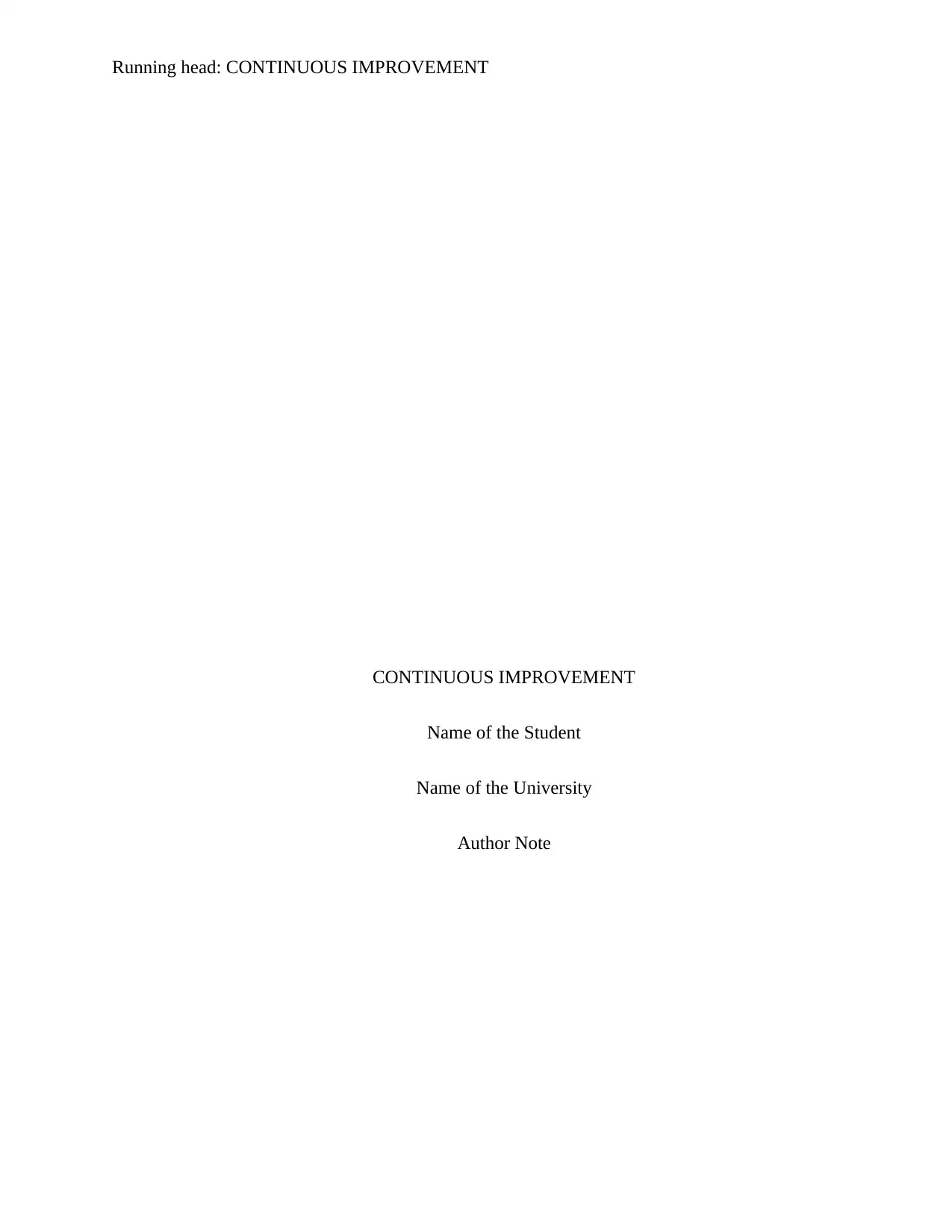
Running head: CONTINUOUS IMPROVEMENT
CONTINUOUS IMPROVEMENT
Name of the Student
Name of the University
Author Note
CONTINUOUS IMPROVEMENT
Name of the Student
Name of the University
Author Note
Secure Best Marks with AI Grader
Need help grading? Try our AI Grader for instant feedback on your assignments.
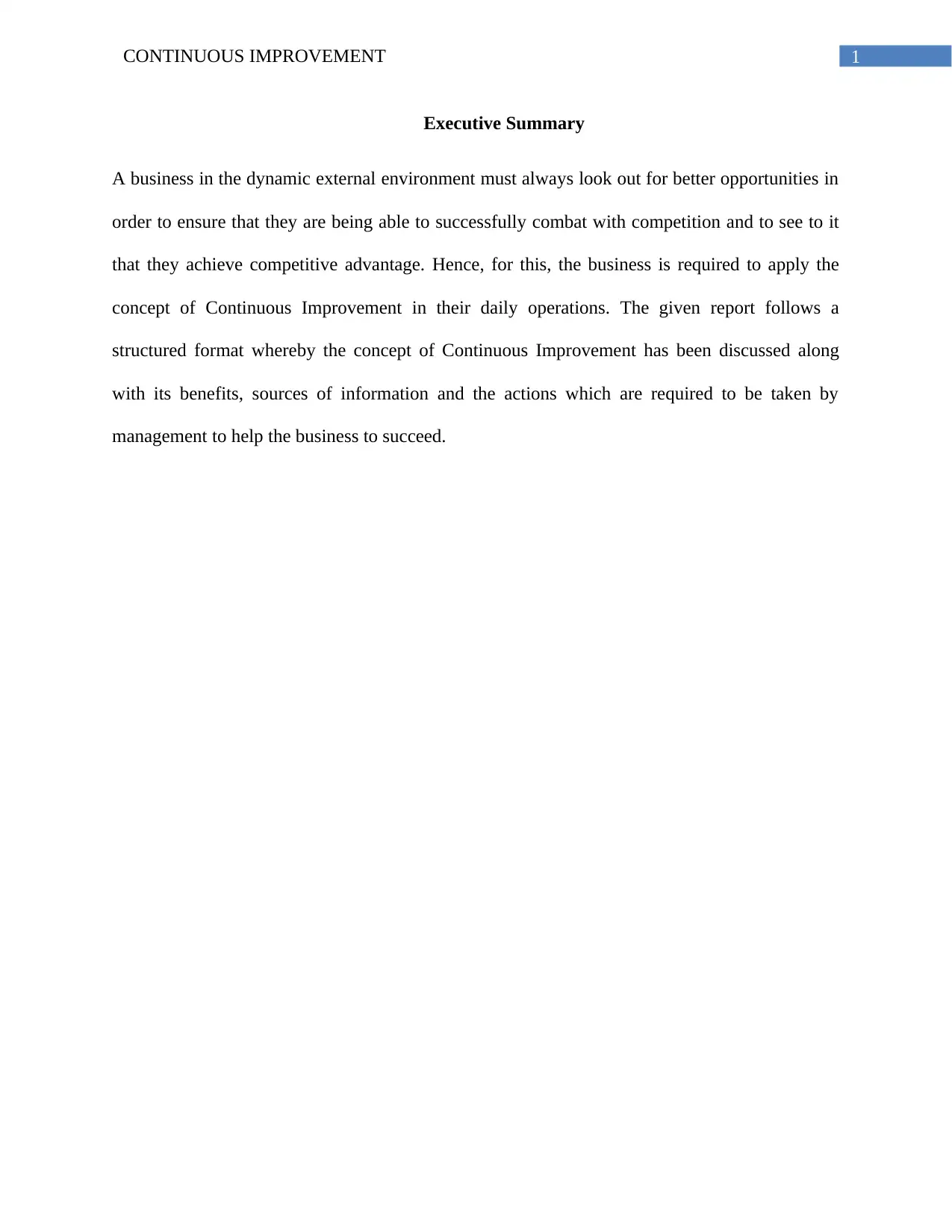
1CONTINUOUS IMPROVEMENT
Executive Summary
A business in the dynamic external environment must always look out for better opportunities in
order to ensure that they are being able to successfully combat with competition and to see to it
that they achieve competitive advantage. Hence, for this, the business is required to apply the
concept of Continuous Improvement in their daily operations. The given report follows a
structured format whereby the concept of Continuous Improvement has been discussed along
with its benefits, sources of information and the actions which are required to be taken by
management to help the business to succeed.
Executive Summary
A business in the dynamic external environment must always look out for better opportunities in
order to ensure that they are being able to successfully combat with competition and to see to it
that they achieve competitive advantage. Hence, for this, the business is required to apply the
concept of Continuous Improvement in their daily operations. The given report follows a
structured format whereby the concept of Continuous Improvement has been discussed along
with its benefits, sources of information and the actions which are required to be taken by
management to help the business to succeed.
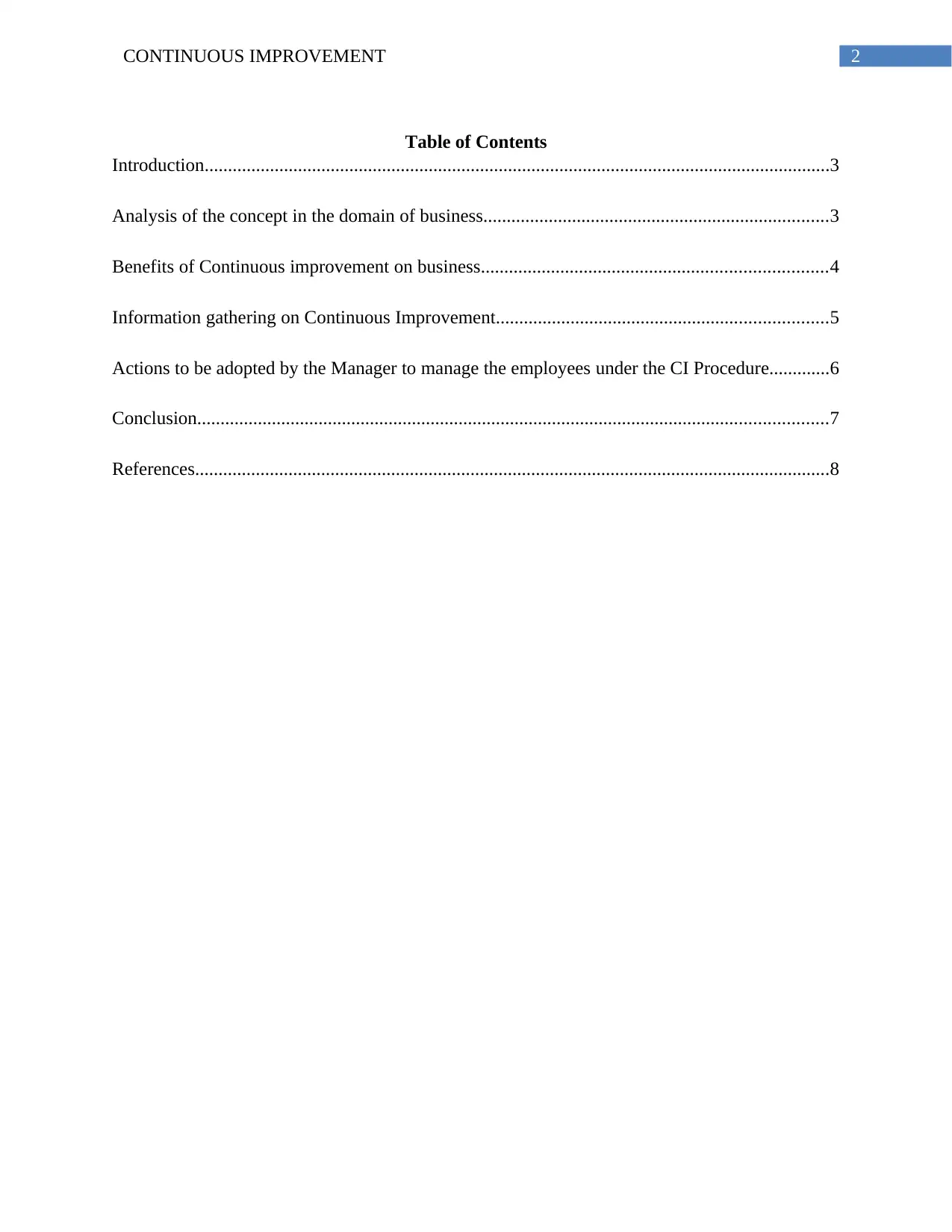
2CONTINUOUS IMPROVEMENT
Table of Contents
Introduction......................................................................................................................................3
Analysis of the concept in the domain of business..........................................................................3
Benefits of Continuous improvement on business..........................................................................4
Information gathering on Continuous Improvement.......................................................................5
Actions to be adopted by the Manager to manage the employees under the CI Procedure.............6
Conclusion.......................................................................................................................................7
References........................................................................................................................................8
Table of Contents
Introduction......................................................................................................................................3
Analysis of the concept in the domain of business..........................................................................3
Benefits of Continuous improvement on business..........................................................................4
Information gathering on Continuous Improvement.......................................................................5
Actions to be adopted by the Manager to manage the employees under the CI Procedure.............6
Conclusion.......................................................................................................................................7
References........................................................................................................................................8
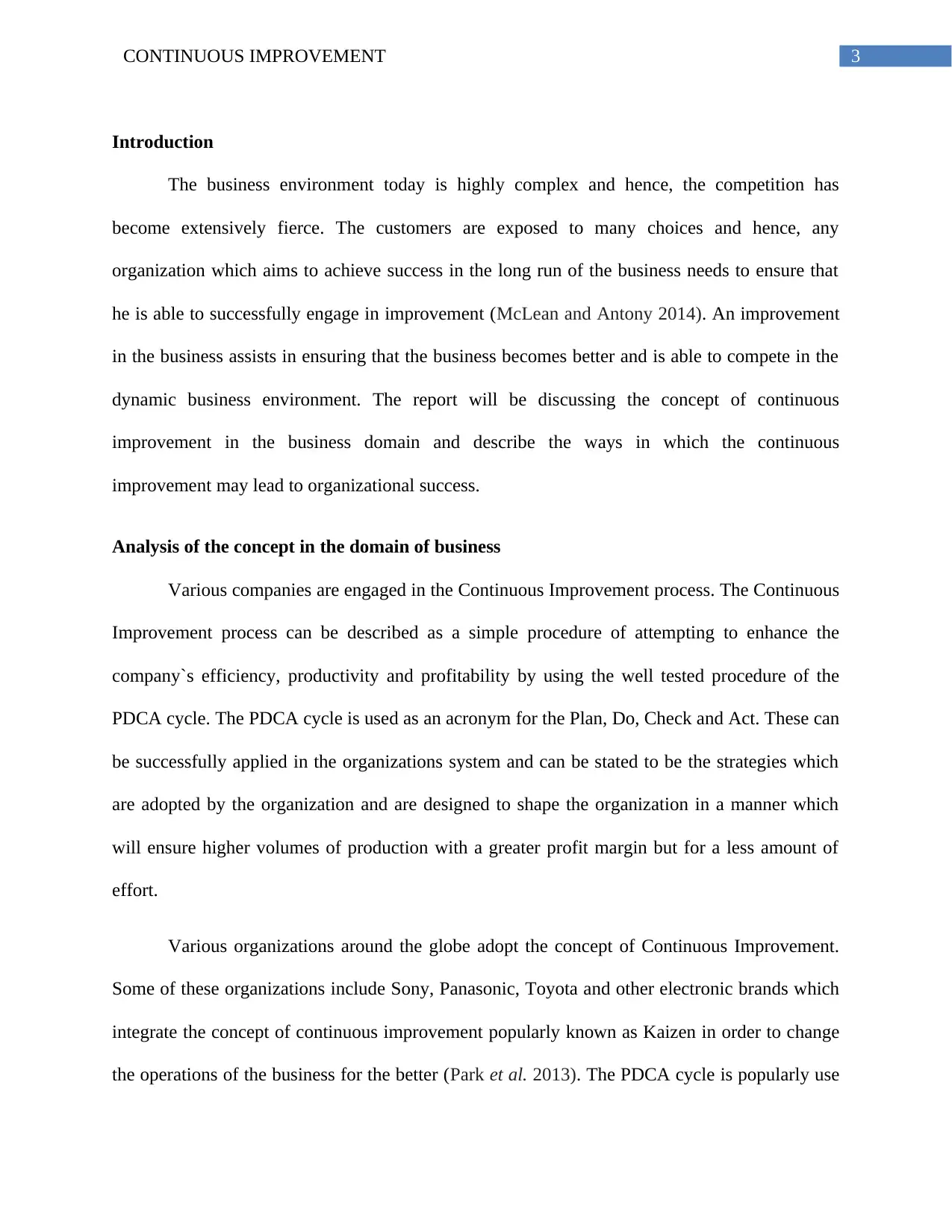
3CONTINUOUS IMPROVEMENT
Introduction
The business environment today is highly complex and hence, the competition has
become extensively fierce. The customers are exposed to many choices and hence, any
organization which aims to achieve success in the long run of the business needs to ensure that
he is able to successfully engage in improvement (McLean and Antony 2014). An improvement
in the business assists in ensuring that the business becomes better and is able to compete in the
dynamic business environment. The report will be discussing the concept of continuous
improvement in the business domain and describe the ways in which the continuous
improvement may lead to organizational success.
Analysis of the concept in the domain of business
Various companies are engaged in the Continuous Improvement process. The Continuous
Improvement process can be described as a simple procedure of attempting to enhance the
company`s efficiency, productivity and profitability by using the well tested procedure of the
PDCA cycle. The PDCA cycle is used as an acronym for the Plan, Do, Check and Act. These can
be successfully applied in the organizations system and can be stated to be the strategies which
are adopted by the organization and are designed to shape the organization in a manner which
will ensure higher volumes of production with a greater profit margin but for a less amount of
effort.
Various organizations around the globe adopt the concept of Continuous Improvement.
Some of these organizations include Sony, Panasonic, Toyota and other electronic brands which
integrate the concept of continuous improvement popularly known as Kaizen in order to change
the operations of the business for the better (Park et al. 2013). The PDCA cycle is popularly use
Introduction
The business environment today is highly complex and hence, the competition has
become extensively fierce. The customers are exposed to many choices and hence, any
organization which aims to achieve success in the long run of the business needs to ensure that
he is able to successfully engage in improvement (McLean and Antony 2014). An improvement
in the business assists in ensuring that the business becomes better and is able to compete in the
dynamic business environment. The report will be discussing the concept of continuous
improvement in the business domain and describe the ways in which the continuous
improvement may lead to organizational success.
Analysis of the concept in the domain of business
Various companies are engaged in the Continuous Improvement process. The Continuous
Improvement process can be described as a simple procedure of attempting to enhance the
company`s efficiency, productivity and profitability by using the well tested procedure of the
PDCA cycle. The PDCA cycle is used as an acronym for the Plan, Do, Check and Act. These can
be successfully applied in the organizations system and can be stated to be the strategies which
are adopted by the organization and are designed to shape the organization in a manner which
will ensure higher volumes of production with a greater profit margin but for a less amount of
effort.
Various organizations around the globe adopt the concept of Continuous Improvement.
Some of these organizations include Sony, Panasonic, Toyota and other electronic brands which
integrate the concept of continuous improvement popularly known as Kaizen in order to change
the operations of the business for the better (Park et al. 2013). The PDCA cycle is popularly use
Secure Best Marks with AI Grader
Need help grading? Try our AI Grader for instant feedback on your assignments.
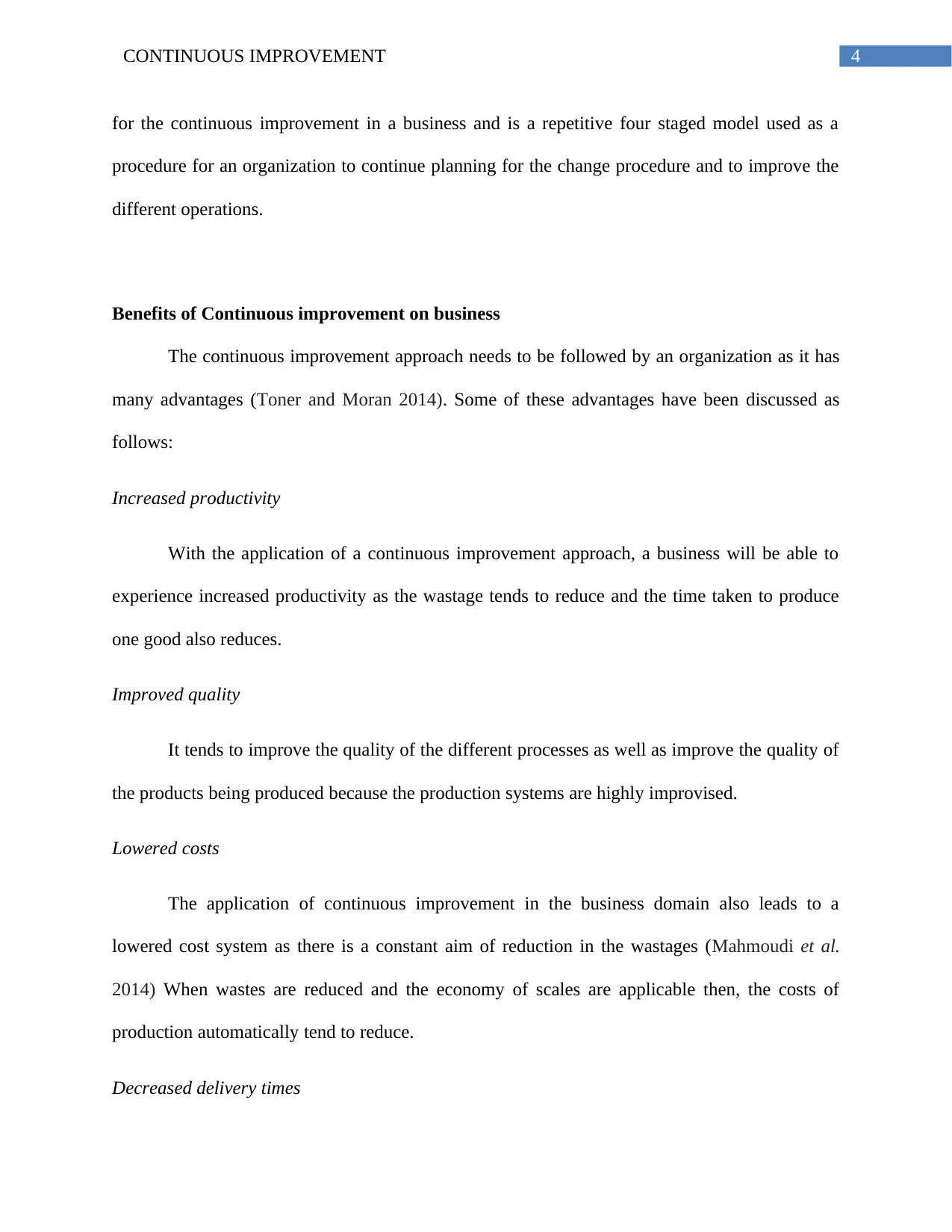
4CONTINUOUS IMPROVEMENT
for the continuous improvement in a business and is a repetitive four staged model used as a
procedure for an organization to continue planning for the change procedure and to improve the
different operations.
Benefits of Continuous improvement on business
The continuous improvement approach needs to be followed by an organization as it has
many advantages (Toner and Moran 2014). Some of these advantages have been discussed as
follows:
Increased productivity
With the application of a continuous improvement approach, a business will be able to
experience increased productivity as the wastage tends to reduce and the time taken to produce
one good also reduces.
Improved quality
It tends to improve the quality of the different processes as well as improve the quality of
the products being produced because the production systems are highly improvised.
Lowered costs
The application of continuous improvement in the business domain also leads to a
lowered cost system as there is a constant aim of reduction in the wastages (Mahmoudi et al.
2014) When wastes are reduced and the economy of scales are applicable then, the costs of
production automatically tend to reduce.
Decreased delivery times
for the continuous improvement in a business and is a repetitive four staged model used as a
procedure for an organization to continue planning for the change procedure and to improve the
different operations.
Benefits of Continuous improvement on business
The continuous improvement approach needs to be followed by an organization as it has
many advantages (Toner and Moran 2014). Some of these advantages have been discussed as
follows:
Increased productivity
With the application of a continuous improvement approach, a business will be able to
experience increased productivity as the wastage tends to reduce and the time taken to produce
one good also reduces.
Improved quality
It tends to improve the quality of the different processes as well as improve the quality of
the products being produced because the production systems are highly improvised.
Lowered costs
The application of continuous improvement in the business domain also leads to a
lowered cost system as there is a constant aim of reduction in the wastages (Mahmoudi et al.
2014) When wastes are reduced and the economy of scales are applicable then, the costs of
production automatically tend to reduce.
Decreased delivery times
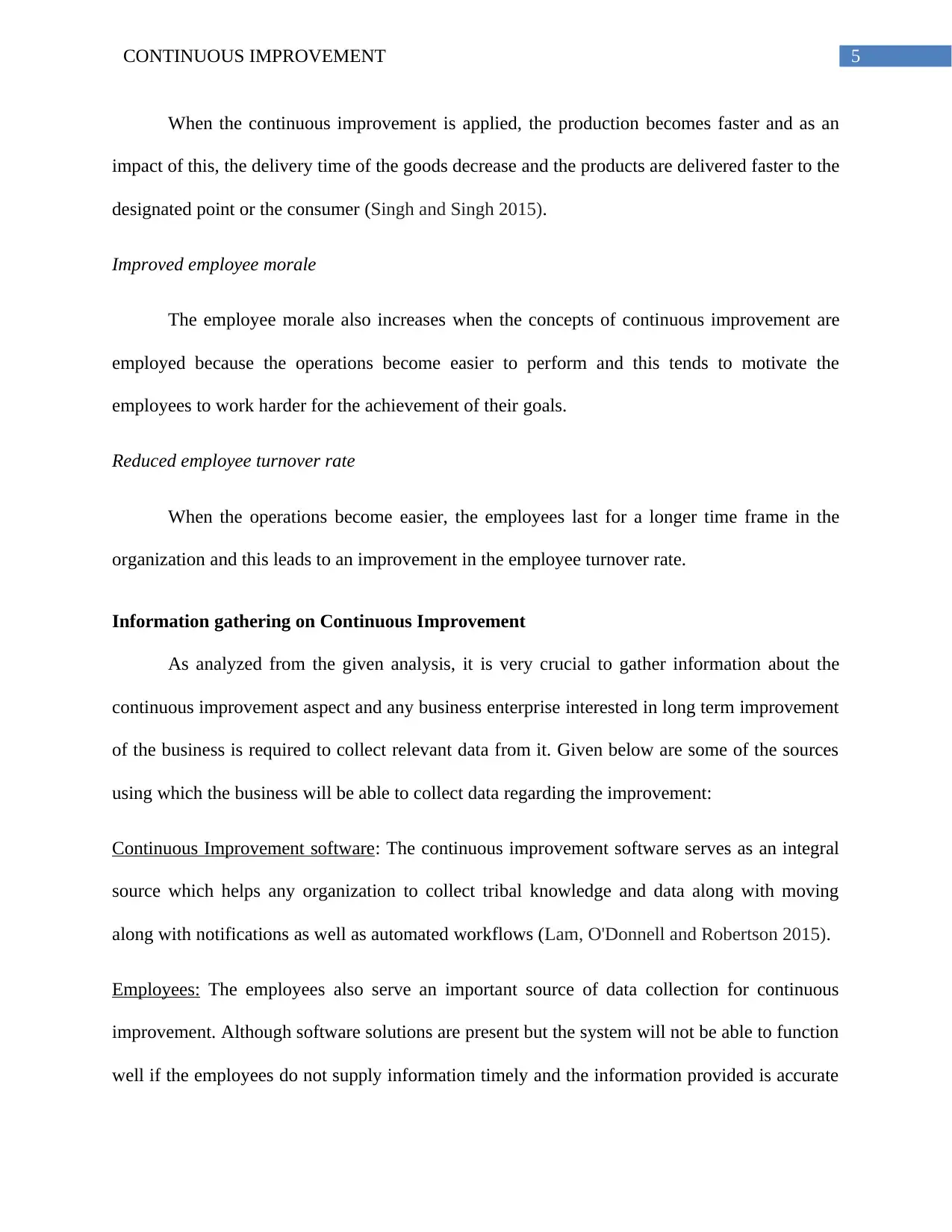
5CONTINUOUS IMPROVEMENT
When the continuous improvement is applied, the production becomes faster and as an
impact of this, the delivery time of the goods decrease and the products are delivered faster to the
designated point or the consumer (Singh and Singh 2015).
Improved employee morale
The employee morale also increases when the concepts of continuous improvement are
employed because the operations become easier to perform and this tends to motivate the
employees to work harder for the achievement of their goals.
Reduced employee turnover rate
When the operations become easier, the employees last for a longer time frame in the
organization and this leads to an improvement in the employee turnover rate.
Information gathering on Continuous Improvement
As analyzed from the given analysis, it is very crucial to gather information about the
continuous improvement aspect and any business enterprise interested in long term improvement
of the business is required to collect relevant data from it. Given below are some of the sources
using which the business will be able to collect data regarding the improvement:
Continuous Improvement software: The continuous improvement software serves as an integral
source which helps any organization to collect tribal knowledge and data along with moving
along with notifications as well as automated workflows (Lam, O'Donnell and Robertson 2015).
Employees: The employees also serve an important source of data collection for continuous
improvement. Although software solutions are present but the system will not be able to function
well if the employees do not supply information timely and the information provided is accurate
When the continuous improvement is applied, the production becomes faster and as an
impact of this, the delivery time of the goods decrease and the products are delivered faster to the
designated point or the consumer (Singh and Singh 2015).
Improved employee morale
The employee morale also increases when the concepts of continuous improvement are
employed because the operations become easier to perform and this tends to motivate the
employees to work harder for the achievement of their goals.
Reduced employee turnover rate
When the operations become easier, the employees last for a longer time frame in the
organization and this leads to an improvement in the employee turnover rate.
Information gathering on Continuous Improvement
As analyzed from the given analysis, it is very crucial to gather information about the
continuous improvement aspect and any business enterprise interested in long term improvement
of the business is required to collect relevant data from it. Given below are some of the sources
using which the business will be able to collect data regarding the improvement:
Continuous Improvement software: The continuous improvement software serves as an integral
source which helps any organization to collect tribal knowledge and data along with moving
along with notifications as well as automated workflows (Lam, O'Donnell and Robertson 2015).
Employees: The employees also serve an important source of data collection for continuous
improvement. Although software solutions are present but the system will not be able to function
well if the employees do not supply information timely and the information provided is accurate
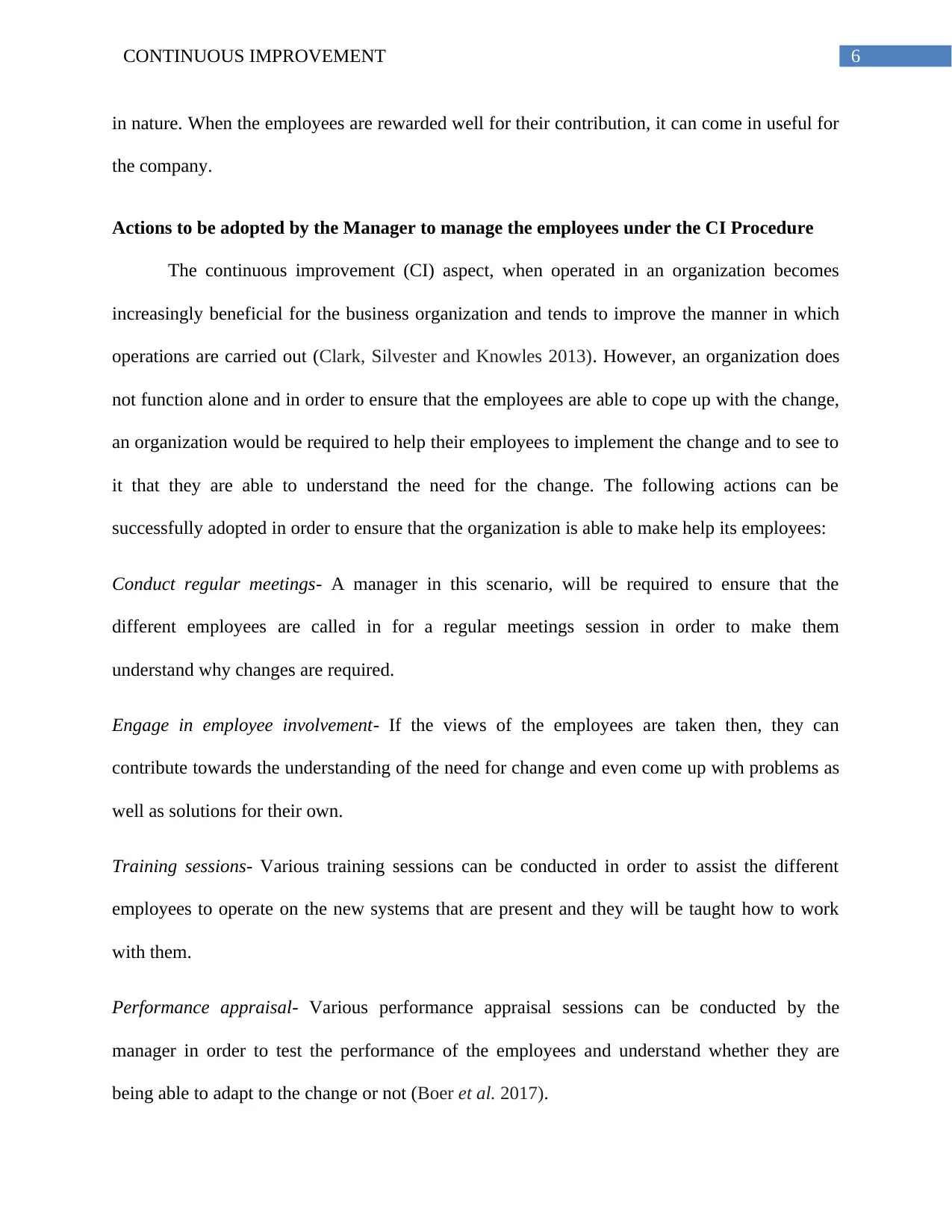
6CONTINUOUS IMPROVEMENT
in nature. When the employees are rewarded well for their contribution, it can come in useful for
the company.
Actions to be adopted by the Manager to manage the employees under the CI Procedure
The continuous improvement (CI) aspect, when operated in an organization becomes
increasingly beneficial for the business organization and tends to improve the manner in which
operations are carried out (Clark, Silvester and Knowles 2013). However, an organization does
not function alone and in order to ensure that the employees are able to cope up with the change,
an organization would be required to help their employees to implement the change and to see to
it that they are able to understand the need for the change. The following actions can be
successfully adopted in order to ensure that the organization is able to make help its employees:
Conduct regular meetings- A manager in this scenario, will be required to ensure that the
different employees are called in for a regular meetings session in order to make them
understand why changes are required.
Engage in employee involvement- If the views of the employees are taken then, they can
contribute towards the understanding of the need for change and even come up with problems as
well as solutions for their own.
Training sessions- Various training sessions can be conducted in order to assist the different
employees to operate on the new systems that are present and they will be taught how to work
with them.
Performance appraisal- Various performance appraisal sessions can be conducted by the
manager in order to test the performance of the employees and understand whether they are
being able to adapt to the change or not (Boer et al. 2017).
in nature. When the employees are rewarded well for their contribution, it can come in useful for
the company.
Actions to be adopted by the Manager to manage the employees under the CI Procedure
The continuous improvement (CI) aspect, when operated in an organization becomes
increasingly beneficial for the business organization and tends to improve the manner in which
operations are carried out (Clark, Silvester and Knowles 2013). However, an organization does
not function alone and in order to ensure that the employees are able to cope up with the change,
an organization would be required to help their employees to implement the change and to see to
it that they are able to understand the need for the change. The following actions can be
successfully adopted in order to ensure that the organization is able to make help its employees:
Conduct regular meetings- A manager in this scenario, will be required to ensure that the
different employees are called in for a regular meetings session in order to make them
understand why changes are required.
Engage in employee involvement- If the views of the employees are taken then, they can
contribute towards the understanding of the need for change and even come up with problems as
well as solutions for their own.
Training sessions- Various training sessions can be conducted in order to assist the different
employees to operate on the new systems that are present and they will be taught how to work
with them.
Performance appraisal- Various performance appraisal sessions can be conducted by the
manager in order to test the performance of the employees and understand whether they are
being able to adapt to the change or not (Boer et al. 2017).
Paraphrase This Document
Need a fresh take? Get an instant paraphrase of this document with our AI Paraphraser
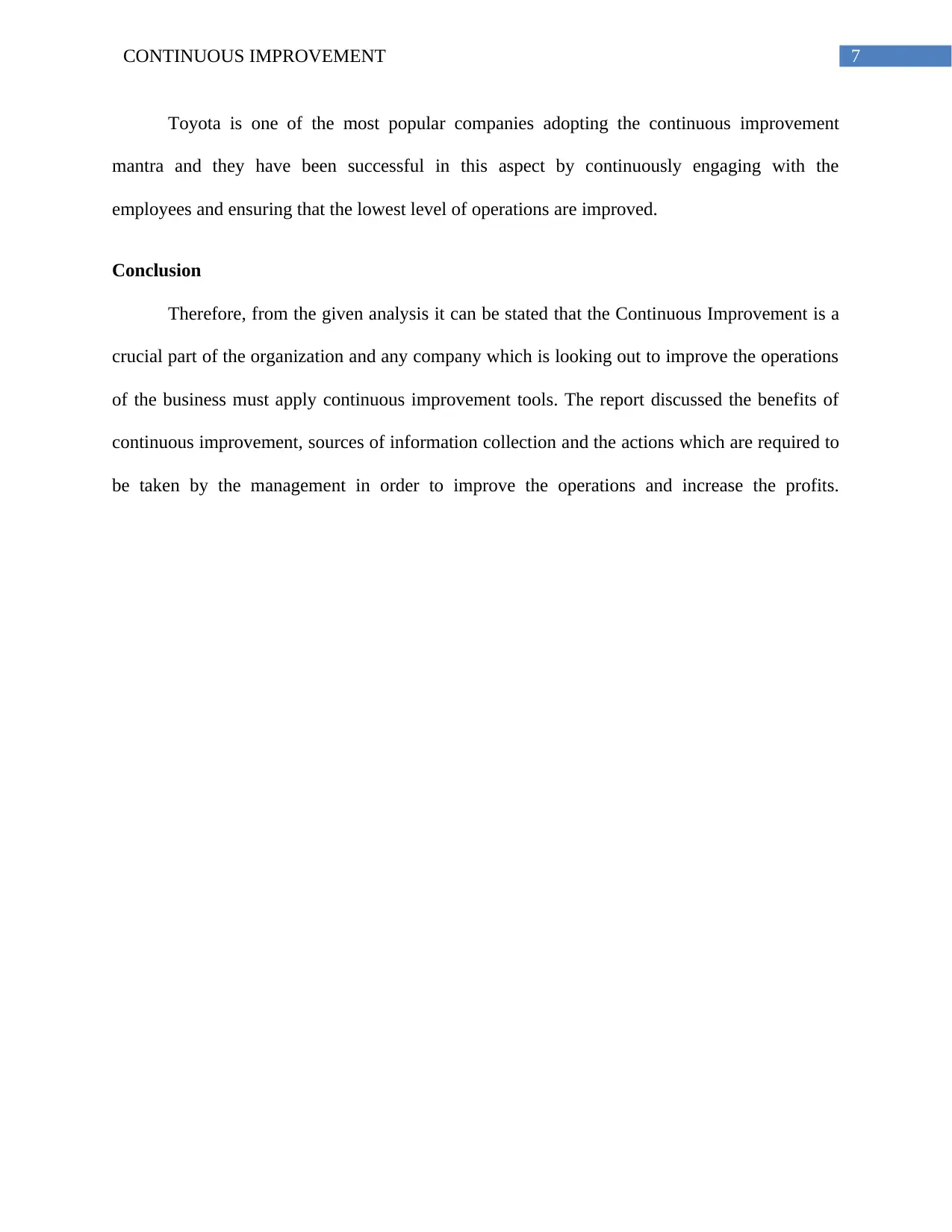
7CONTINUOUS IMPROVEMENT
Toyota is one of the most popular companies adopting the continuous improvement
mantra and they have been successful in this aspect by continuously engaging with the
employees and ensuring that the lowest level of operations are improved.
Conclusion
Therefore, from the given analysis it can be stated that the Continuous Improvement is a
crucial part of the organization and any company which is looking out to improve the operations
of the business must apply continuous improvement tools. The report discussed the benefits of
continuous improvement, sources of information collection and the actions which are required to
be taken by the management in order to improve the operations and increase the profits.
Toyota is one of the most popular companies adopting the continuous improvement
mantra and they have been successful in this aspect by continuously engaging with the
employees and ensuring that the lowest level of operations are improved.
Conclusion
Therefore, from the given analysis it can be stated that the Continuous Improvement is a
crucial part of the organization and any company which is looking out to improve the operations
of the business must apply continuous improvement tools. The report discussed the benefits of
continuous improvement, sources of information collection and the actions which are required to
be taken by the management in order to improve the operations and increase the profits.
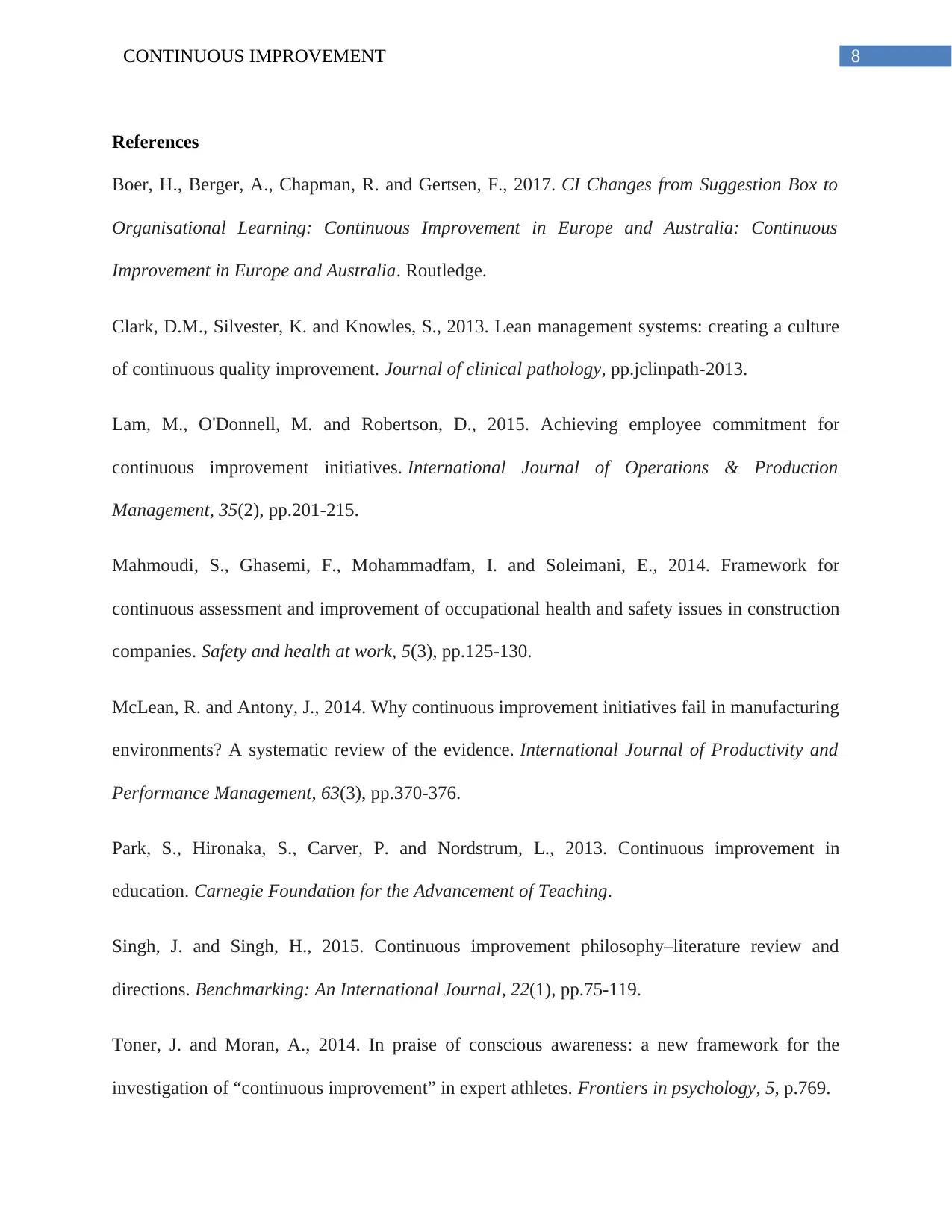
8CONTINUOUS IMPROVEMENT
References
Boer, H., Berger, A., Chapman, R. and Gertsen, F., 2017. CI Changes from Suggestion Box to
Organisational Learning: Continuous Improvement in Europe and Australia: Continuous
Improvement in Europe and Australia. Routledge.
Clark, D.M., Silvester, K. and Knowles, S., 2013. Lean management systems: creating a culture
of continuous quality improvement. Journal of clinical pathology, pp.jclinpath-2013.
Lam, M., O'Donnell, M. and Robertson, D., 2015. Achieving employee commitment for
continuous improvement initiatives. International Journal of Operations & Production
Management, 35(2), pp.201-215.
Mahmoudi, S., Ghasemi, F., Mohammadfam, I. and Soleimani, E., 2014. Framework for
continuous assessment and improvement of occupational health and safety issues in construction
companies. Safety and health at work, 5(3), pp.125-130.
McLean, R. and Antony, J., 2014. Why continuous improvement initiatives fail in manufacturing
environments? A systematic review of the evidence. International Journal of Productivity and
Performance Management, 63(3), pp.370-376.
Park, S., Hironaka, S., Carver, P. and Nordstrum, L., 2013. Continuous improvement in
education. Carnegie Foundation for the Advancement of Teaching.
Singh, J. and Singh, H., 2015. Continuous improvement philosophy–literature review and
directions. Benchmarking: An International Journal, 22(1), pp.75-119.
Toner, J. and Moran, A., 2014. In praise of conscious awareness: a new framework for the
investigation of “continuous improvement” in expert athletes. Frontiers in psychology, 5, p.769.
References
Boer, H., Berger, A., Chapman, R. and Gertsen, F., 2017. CI Changes from Suggestion Box to
Organisational Learning: Continuous Improvement in Europe and Australia: Continuous
Improvement in Europe and Australia. Routledge.
Clark, D.M., Silvester, K. and Knowles, S., 2013. Lean management systems: creating a culture
of continuous quality improvement. Journal of clinical pathology, pp.jclinpath-2013.
Lam, M., O'Donnell, M. and Robertson, D., 2015. Achieving employee commitment for
continuous improvement initiatives. International Journal of Operations & Production
Management, 35(2), pp.201-215.
Mahmoudi, S., Ghasemi, F., Mohammadfam, I. and Soleimani, E., 2014. Framework for
continuous assessment and improvement of occupational health and safety issues in construction
companies. Safety and health at work, 5(3), pp.125-130.
McLean, R. and Antony, J., 2014. Why continuous improvement initiatives fail in manufacturing
environments? A systematic review of the evidence. International Journal of Productivity and
Performance Management, 63(3), pp.370-376.
Park, S., Hironaka, S., Carver, P. and Nordstrum, L., 2013. Continuous improvement in
education. Carnegie Foundation for the Advancement of Teaching.
Singh, J. and Singh, H., 2015. Continuous improvement philosophy–literature review and
directions. Benchmarking: An International Journal, 22(1), pp.75-119.
Toner, J. and Moran, A., 2014. In praise of conscious awareness: a new framework for the
investigation of “continuous improvement” in expert athletes. Frontiers in psychology, 5, p.769.
1 out of 9
Related Documents
Your All-in-One AI-Powered Toolkit for Academic Success.
+13062052269
info@desklib.com
Available 24*7 on WhatsApp / Email
![[object Object]](/_next/static/media/star-bottom.7253800d.svg)
Unlock your academic potential
© 2024 | Zucol Services PVT LTD | All rights reserved.





